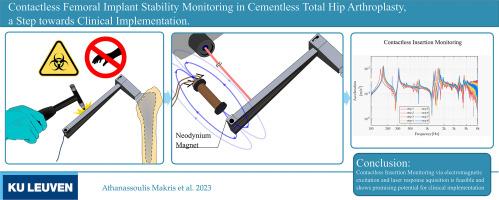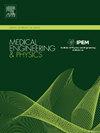非接触式股骨植入物稳定性监测在无骨水泥全髋关节置换术中的应用,向临床应用迈出的一步
IF 1.7
4区 医学
Q3 ENGINEERING, BIOMEDICAL
引用次数: 0
摘要
在无骨水泥全髋关节置换术中,通过基于振动的方法对股骨植入物进行术中固定监测,由于实际操作和监管问题,目前使用的设备在临床上的实施具有挑战性。受电磁激励在类似牙科应用中的有效性启发,本研究调查了在无骨水泥全髋关节置换术中使用电磁激励进行股骨植入物稳定性监测的情况。通过电磁激励获得的结果与通过冲击激励获得的参考结果基本一致,在 0.1-8 kHz 频段的皮尔逊相关系数为 0.79。此外,通过两种方法获得的峰值频率的相对差异为 0.20 ± 0.22 %。接下来,我们成功地将激振装置与激光测振仪结合使用,在体外植入过程中监测股骨植入物的稳定性,证明了非接触式植入物稳定性监测的可行性。这些结果表明,这种非接触式方法在临床应用中大有可为。本文章由计算机程序翻译,如有差异,请以英文原文为准。

Contactless femoral implant stability monitoring in cementless total hip arthroplasty, A step towards clinical implementation
The clinical implementation of currently used devices for intraoperative fixation monitoring of femoral implants via vibration-based methods in cementless total hip arthroplasty is challenging, due to practical and regulatory issues. Motivated by the effectiveness of electromagnetic excitation in similar dental applications, this study investigates the use of electromagnetic excitation for femoral implant stability monitoring during cementless total hip arthroplasty. The results obtained from electromagnetic excitation were largely consistent with reference results obtained through impact excitation, with a Pearson Correlation Coefficient of 0.79 in the 0.1–8 kHz frequency band. Moreover, the peak frequencies obtained via the two methods yielded a relative difference of 0.20 ± 0.22 %. Next, the excitation device was successfully utilized in conjunction with a laser vibrometer to monitor the stability of the femoral implant during an in vitro insertion, proving the feasibility of contactless implant stability monitoring. These results indicate the promising potential of this contactless method for clinical implementation.
求助全文
通过发布文献求助,成功后即可免费获取论文全文。
去求助
来源期刊

Medical Engineering & Physics
工程技术-工程:生物医学
CiteScore
4.30
自引率
4.50%
发文量
172
审稿时长
3.0 months
期刊介绍:
Medical Engineering & Physics provides a forum for the publication of the latest developments in biomedical engineering, and reflects the essential multidisciplinary nature of the subject. The journal publishes in-depth critical reviews, scientific papers and technical notes. Our focus encompasses the application of the basic principles of physics and engineering to the development of medical devices and technology, with the ultimate aim of producing improvements in the quality of health care.Topics covered include biomechanics, biomaterials, mechanobiology, rehabilitation engineering, biomedical signal processing and medical device development. Medical Engineering & Physics aims to keep both engineers and clinicians abreast of the latest applications of technology to health care.
 求助内容:
求助内容: 应助结果提醒方式:
应助结果提醒方式:


